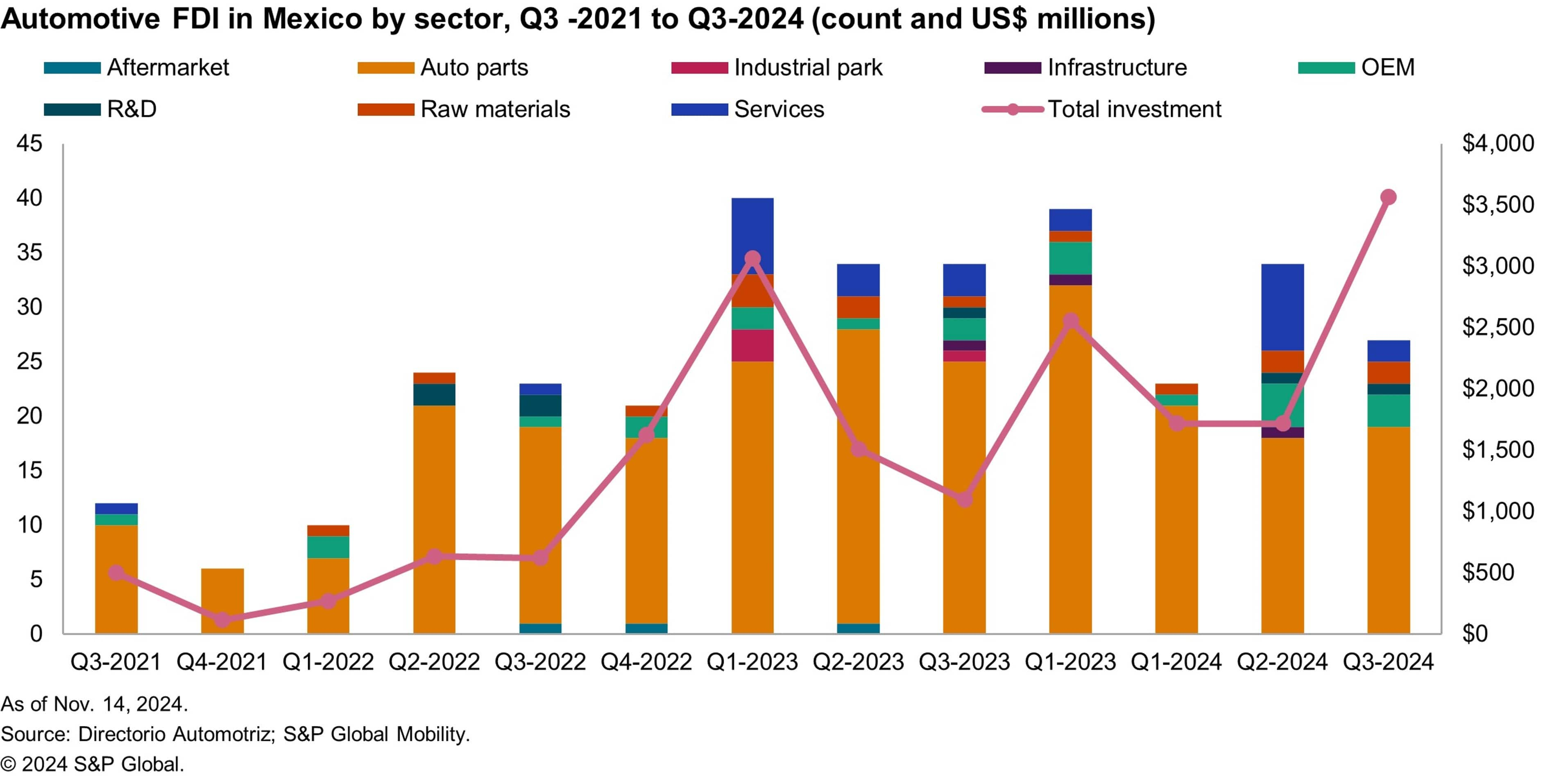Discover more about S&P Global's offerings
Customer Logins
Obtain the data you need to make the most informed decisions by accessing our extensive portfolio of information, analytics, and expertise. Sign in to the product or service center of your choice.
Customer Logins
BLOG
Nov 20, 2024
BriefCASE: Tariff trouble - Will Mexico's auto investment engine splutter?
In the aftermath of the US election, President-elect Donald Trump's return to the Oval Office has sparked speculation about his intentions during his second term, particularly regarding the automotive sector. As the world observes, the intersections of politics, industry, and trade have become focal points, with the administration's stance on the Inflation Reduction Act (IRA) and its impact on electric vehicle supply chains at the forefront. Additionally, the alliance between Elon Musk and the Trump campaign introduces a new dynamic. Amid these developments, Trump's "America First" doctrine looms large, poised to reshape trade relationships and unsettle foreign investments. We can be more certain about Trump's "America First" approach. In his first administration, this meant imposing tariffs or threatening them as a negotiation lever. The target of these tariffs depended on the direction of travel and the size of the US trade deficit with various partners. For reference, the three biggest contributors to the US' US$1.14 trillion deficit are — in order — mainland China, the EU and Mexico. As documented previously, Mexico has achieved great success in attracting foreign direct investment (FDI) into its automotive sector, according to data from Directorio Automotriz. In the first three quarters of 2024, auto investment has continued to flow into Mexico, albeit at a slower rate (a decrease of 13.6%) compared to 2023. During this period, the value of auto FDI from mainland China has increased by over 86% to US$3.5 billion. Given where the future administration's gaze is likely to rest, the increased mainland Chinese investment will raise concerns. Thus, it is not surprising that on the campaign trail, Trump raised the prospect of rewriting the United States-Mexico-Canada Agreement (USMCA) trade agreement. Additionally, while campaigning in North Carolina, Trump posited a 25% to 75% tariff on all Mexican goods — not just light vehicles — if the country did not assist the US in curbing illegal immigration. This threat is implicit in requiring a rewrite of the USMCA. A six-year renegotiation provision is included in the original USMCA, meaning that renegotiations are scheduled to begin in July 2026. However, there will be much more horse-trading and public pronouncements before then. And therein lies the problem. Tariff or no tariff, large capital expenditure projects—such as automotive investments—require certainty in the business environment and clarity of policy before any dollars are committed. Thus, much of the focus on the USMCA renegotiation will be on Mexico due to the trade deficit. It will be revealing to see whether Mexican automotive FDI is sustained. To date in 2024, the volume of investments has slowed compared to 2023, even though the value of FDI peaked in the third quarter of 2024, with over US$3.5 billion invested.
Cumulatively, mainland China is the largest source of FDI for Mexico's automotive sector. Interestingly, the country contributing most to its cumulative investment in the third quarter of 2024 was the US, which may indicate that companies want to secure investments before USMCA rules are changed—something the Democrats also vowed to review during the campaign. Mexico has thrived as an FDI location due to its access to sizeable markets through various trade agreements. However, the biggest draw for companies remains tariff-free access to neighboring markets via the USMCA. These benefits were also offered under the previous NAFTA agreement, and little has materially changed since the USMCA became operable in 2020. Both agreements have attracted original equipment manufacturers (OEMs) to build vehicle manufacturing capacity in Mexico; and where OEMs tread their suppliers will follow. Between 2015 and 2025, Mexico is set to be the third-largest contributor to global light vehicle capacity growth. According to S&P Global Mobility data, just over 2 million units of capacity will be added, giving Mexico a 31.2% share of total global capacity growth. Where the USMCA does differ from NAFTA is that it aims to encourage increases in Mexican labor rates and improved employment standards. Colleagues at S&P Global Mobility expect the 2026 renewal talks to focus on narrowing the Mexican wage rate differential compared to the US and Canada. This analysis pre-supposes that the Trump administration will wait until July 2026 to review the USMCA. However, Trump is unconventional in his approach to government. Reports suggest the administration may impose 100% tariffs on car imports from Mexico, violating the USMCA agreement. However, the USMCA does allow for tariffs to be imposed on a member in certain circumstances. Such circumstances include: National security concerns including defense and national infrastructure, non-compliance with labor and environmental standards, or if trade remedies are required whereby surging imports harm local industries and anti-dumping and countervailing tariffs are required. If the Trump administration were to pull any of the available levers, or threaten to, the febrile and uncertain environment would intensify and dampen automotive investment commitments in Mexico. By subscribing to AutoTechInsight, you can quickly gain intel on market developments and technology trends, dive into granular forecasts, and seamlessly drive analytics to support challenging decision-making. |
This article was published by S&P Global Mobility and not by S&P Global Ratings, which is a separately managed division of S&P Global.
{"items" : [
{"name":"share","enabled":true,"desc":"<strong>Share</strong>","mobdesc":"Share","options":[ {"name":"facebook","url":"https://www.facebook.com/sharer.php?u=http%3a%2f%2fstage.www.spglobal.com%2fmobility%2fen%2fresearch-analysis%2fbriefcase-tariff-trouble-mexicos-auto-investment.html","enabled":true},{"name":"twitter","url":"https://twitter.com/intent/tweet?url=http%3a%2f%2fstage.www.spglobal.com%2fmobility%2fen%2fresearch-analysis%2fbriefcase-tariff-trouble-mexicos-auto-investment.html&text=BriefCASE%3a+Tariff+trouble+-+Will+Mexico%27s+auto+investment+engine+splutter%3f+++++%7c+S%26P+Global+","enabled":true},{"name":"linkedin","url":"https://www.linkedin.com/sharing/share-offsite/?url=http%3a%2f%2fstage.www.spglobal.com%2fmobility%2fen%2fresearch-analysis%2fbriefcase-tariff-trouble-mexicos-auto-investment.html","enabled":true},{"name":"email","url":"?subject=BriefCASE: Tariff trouble - Will Mexico's auto investment engine splutter? | S&P Global &body=http%3a%2f%2fstage.www.spglobal.com%2fmobility%2fen%2fresearch-analysis%2fbriefcase-tariff-trouble-mexicos-auto-investment.html","enabled":true},{"name":"whatsapp","url":"https://api.whatsapp.com/send?text=BriefCASE%3a+Tariff+trouble+-+Will+Mexico%27s+auto+investment+engine+splutter%3f+++++%7c+S%26P+Global+ http%3a%2f%2fstage.www.spglobal.com%2fmobility%2fen%2fresearch-analysis%2fbriefcase-tariff-trouble-mexicos-auto-investment.html","enabled":true}]}, {"name":"rtt","enabled":true,"mobdesc":"Top"}
]}



